#benedetto bordone
Photo

Poliphilo in the wood.
From Francesco Colonna, Hypnerotomachia Poliphili, Venice, Aldus Manutius, 1499.
#Francesco Colonna#colonna#hypnerotomachia poliphili#poliphili#selva#wood#forest#foret#dream#lost#aldo manuzio#venezia#xilography#renaissance#engraving#art#benedetto bordone#woodcut
26 notes
·
View notes
Photo
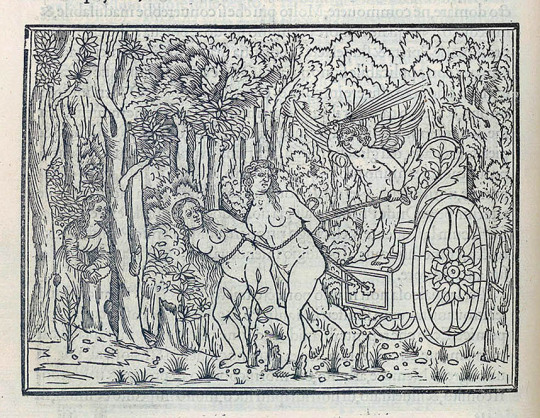
È PIÙ SACRO VEDERE CHE CREDERE - HYPNEROTOMACHIA POLIPHILI
Il preponderante aspetto mentale dell’amore coincide perfettamente con il suo preponderante aspetto carnale. La più lampante o, forse, splendente dimostrazione di questo assunto ce la offre l’“HypnerotomachiaPoliphili”, lo struggente romanzo che il frate Francesco Colonna compose per amore di Polia alla fine del Rinascimento usando le parole ardimentose di una lingua inesistente e quelle immagini imperiture ed esatte che ognuno può trovare da sé nell’anima. Il romanzo è un lungo viaggio iniziatico alla ricerca della donna amata, e offre, inevitabilmente, il finale più triste della storia della letteratura. Inevitabilmente, perché questo romanzo, dato alle stampe al principiare della Riforma e della Controriforma, annuncia che l’epoca cui dava avvio Lutero, l’epoca che stiamo ancora vivendo, non avrebbe più conosciuto l’amore. La spiritualizzazione del corpo che chiamiamo materialismo e il concretismo spirituale che costituisce il fondo gelato della psicopatia dell’epoca che attraversiamo come fossimo i fantasmi di noi stessi, annuncia Francesco Colonna, ridurranno l’amore a uno sfogo dei sensi o a un sentimento dovuto. Flos sic exsiccatus, nunquam reviviscit: il fiore dell’amore, così seccato, non rinascerà mai più.
Le immagini sono xilografie tratte dall' "Hypnerotomachia Poliphili", opera attribuita a Francesco Colonna e pubblicata da Aldo Manuzio nel 1499. Le 172 incisioni (tra cui 39 iniziali floriate e 11 illustrazioni a piena pagina) sono state attribuite al miniaturista padovano Benedetto Bordon (o Bordone). Esse mostrano un meraviglioso senso del movimento: in diversi casi, infatti, pannelli successivi illustrano la storia in un effetto quasi cinematografico. Qui vi presentiamo “Il sogno di Polia”, durante il quale Cupido costringe due donne che hanno resistito al suo potere a trascinare il suo carro, poi taglia senza pietà i loro corpi in pezzi e infine galleggia trionfalmente mentre un drago, un leone e un lupo consumano i loro resti (immagini nel pubblico dominio, tramite Internet Archive)
Testo di Pier Paolo Di Mino
Ricerca iconografica a cura di Veronica Leffe.
https://www.libroazzurro.it/index.php/note/e-piu-sacro-vedere-che-credere/162
0 notes
Photo

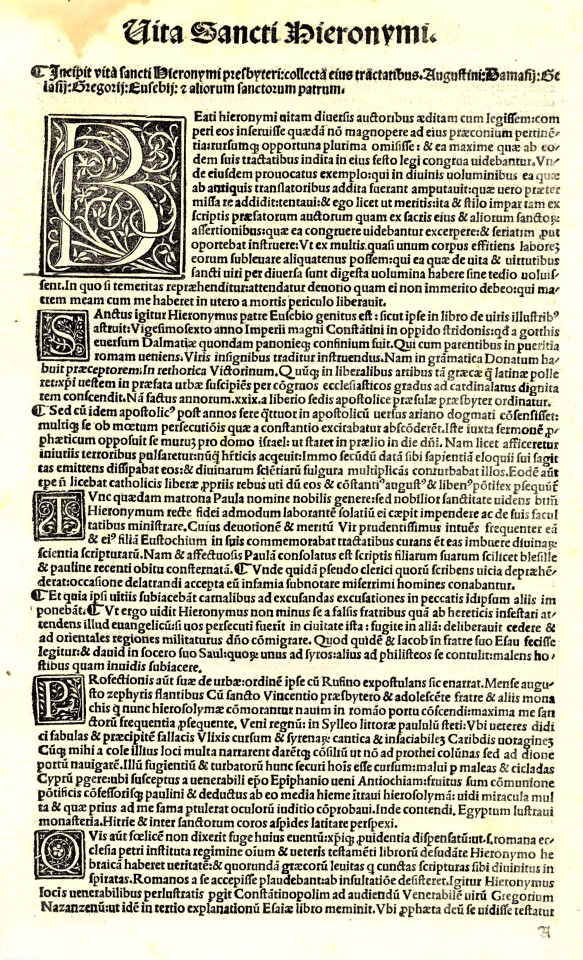


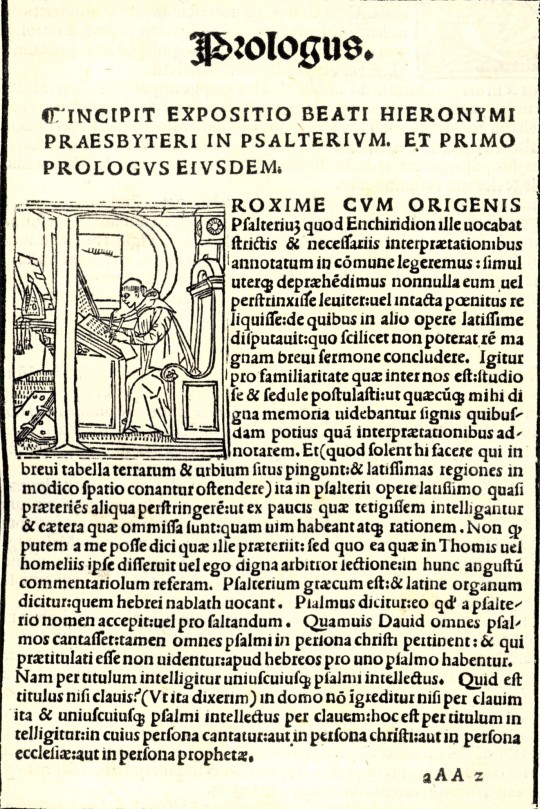
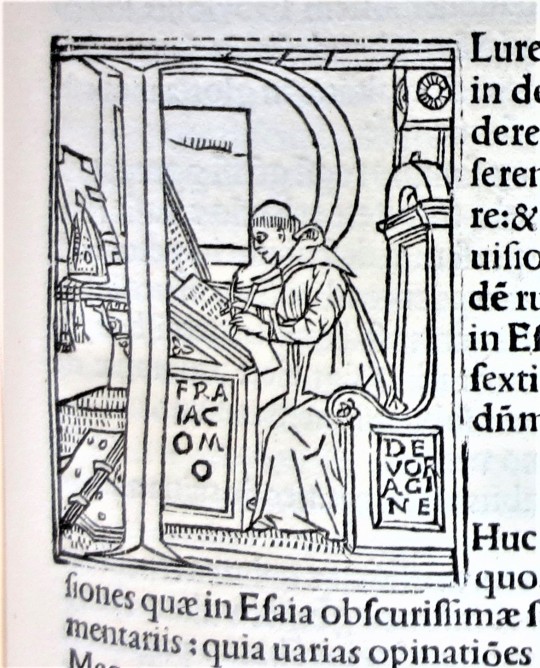
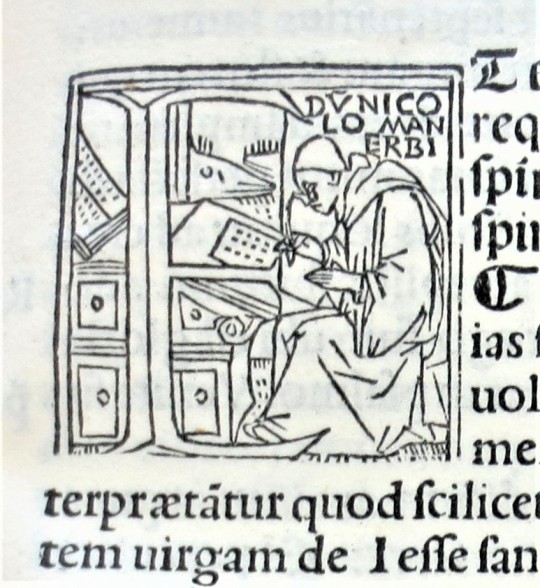
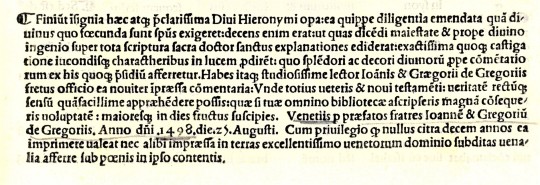
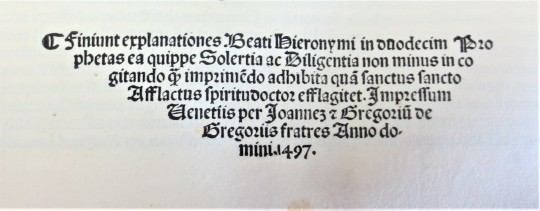
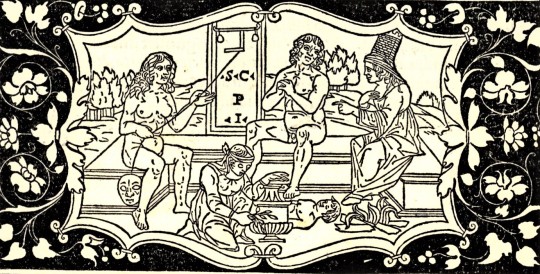
Typography Tuesday
GIOVANNI AND GREGORIO DE GREGORI
Among our collection of incunables (books printed before 1501) is a two-volume Venetian edition of St. Jerome’s biblical commentaries, Commentaria in Bibliam, edited by the scholar monk Bernardino Gadolo for the Gregori brothers, Giovanni and Gregorio (originally from the city of Forli, therefore often referred to in Latin as Joannes et Gregorius de Gregoriis, de Forlivio), and printed in 1497 and 1498.
The Gregori brothers began their printing business in Venice around 1480, and were certainly producing books by 1482. They continued printing together until at least 1505 (when Giovanni may have died), after which Gregorio printed on his own until about 1510. They were known for their fine typography in both Roman and Gothic fonts and were among the first to design and cast a tiny, elegant, and readable Roman typeface in what was known as the nonpareil size, or 6-pt. font, which they produced right around the same time as the printing of these volumes. In 1886, the noted American printer and type scholar Theodore Low De Vinne observed about this “remarkably neat Roman letter on a nonpareil body” that:
Considering the difficulty of cutting symmetrical letters on so small a body, and of casting them in types at this early period in the history of type founding, when tools were imperfect and experience was limited, this font of nonpareil may be regarded as a feat in type founding. . . . Types as small had been made before. . . . but these types . . . were not well cut or cast.
The elegance of their type design in both Roman and Gothic fonts is clear from the examples shown here. Gregorio was also a skilled woodcut artist and probably produced many of the decorative and historiated initials in these volumes. The fine woodcut border for the incipit of the Expositio in Psalterium shown here, however, is a re-use of one of the finest woodcut borders of the fifteenth century, drawn and cut by the Paduan-born Venetian miniaturist Benedetto Bordone for a Herodotus issued by the Gregori brothers in 1494.
The border frames a text that includes a fourteen-line historiated initial showing St. Jerome at his desk. There are several other scholar portraits that serve as historiated initials in these volumes. Shown here, for example, is the initial P, the same as the one used for Jerome, but identified here as the medieval scholar and archbishop of Genoa Jacobus de Varagine. Another for the initial E is identified as the 15th-century Italian biblical scholar Nicolò Manerbi (or Malermi).
View some of our other incunabula.
View our other Typography Tuesday posts.
#Typography Tuesday#typetuesday#Giovanni and Gregorio de Gregori#Joannes et Gregorius de Gregoriis de Forlivio#Gregori bothers#nonpareil type#incunabula#Roman fonts#Gothic type#15th century type#St. Jerome#Commentaria in Bibliam#Theodore Low De Vinne#Bernardino Gadolo#Benedetto Bordone#Jacobus de Varagine#Nicolò Malermi#historiated initials#woodcut initials#Typography Tuesday
76 notes
·
View notes
Photo
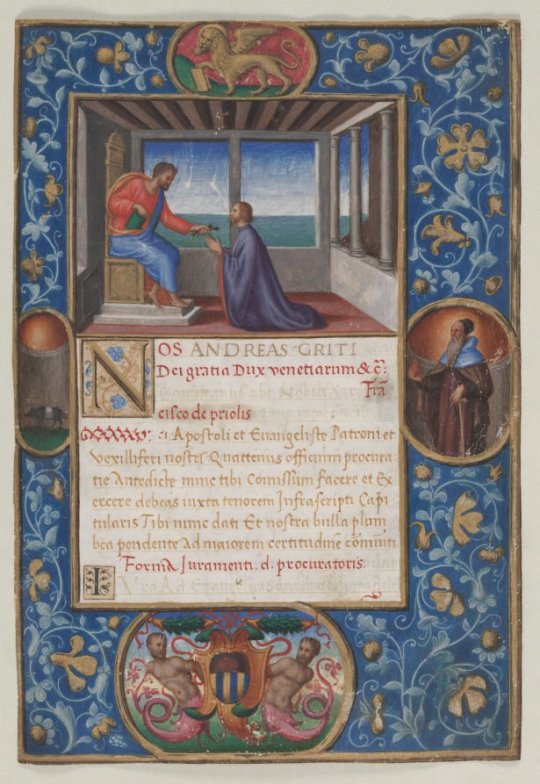
Leaf from a Commission: St. Mark Giving the Keys of Venice to Francesco de Priuli, Benedetto Bordone, c. 1523-1524, Cleveland Museum of Art: Medieval Art
The miniature shows the enthroned figure of Saint Mark, patron saint of Venice, presenting the symbolic keys of Venice to the kneeling figure of Francesco de Priuli upon his appointment as Procurator of Saint Mark's. Beneath the miniature are twelve lines of text, the opening of a ducale issued by Doge Andrea Gritti (1523–38) announcing de Priuli's appointment, which was made in the early 1520s. The text begins, Nos Andreas Griti, Dei gratia Dux venetiarum (Our Andrea Gritti, By the Grace of God Duke of the Venetians). The illumination relates closely to the work of Benedetto Bordon, a Paduan-born miniaturist who became prominent in Venice. The decorative borders appear to be edged in thin gilt-bronze bars that give the illusion of fine metalwork. Four oval cartouches are occupied by the Lion of Saint Mark (top), the de Priuli arms (bottom), Saint Anthony the Great (right), and his symbol, a swine (left). The Priuli Arms below are festooned with wreaths and supported by mermen with horns and pink tails. This exquisite leaf exemplifies the changes in script, page layout, border decoration, and binding developed by the Italian humanist culture of the 1400s.
Size: Leaf: 23.1 x 15.7 cm (9 1/8 x 6 3/16 in.)
Medium: ink, tempera and gold on vellum
https://clevelandart.org/art/2011.69
10 notes
·
View notes
Photo
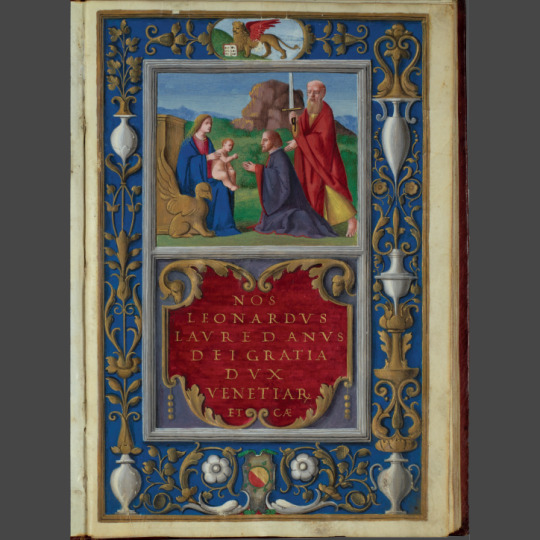
Commissione issued to Paolo di Giorgio Nani by Leonardo Loredan Venice, 1517; illuminator: Benedetto Bordone University of Pennsylvania, Lawrence J. Schoenberg Collection, LJS 59 This manuscript is an elaborately decorated commissione issued during the dogeship of Leonardo Loredan (1501-17). The document was issued to Paolo di Giorgio Nani and designates him as podestà and capitaneus of the important inland town of Treviso. The elaborate frame of all’antica ornamentation composed of silver-gray vases and shell gold volutes is set against a deep blue background, and the central image shows Saint Paul presenting a kneeling Nani to the enthroned Virgin and Child. The image is a simplified version of large-scale compositions by contemporary Venetian painters, notably Giovanni Bellini (ca. 1430–1516) and Vincenzo Catena (ca. 1480–1531).
#makingtherenaissancemanuscript#manuscript#venice#commissione#bellini#catena#penn#sims#kislakcenter#philadelphia#renaissancemanuscripts#earlymodernbooks#16thcentury#saintpaul#virginandchild#exhibition
14 notes
·
View notes
Text
All’antica: Getting up-to-date with the Ancients
Fifty-two discoveries from the BiblioPhilly project, No. 21/52
Commissione issued to Andrea Valier by Leonardo Loredan, 1502, Bethlehem, Lehigh University, Linderman Library, Codex 21, fol. 1r (all’antica frontispiece illuminated by the First Pisani Master)
It is always gratifying to learn that one’s own manuscript “discovery” has already been made. Knowing that other scholars have come to the same opinion independently helps to confirm one’s intuitions and demonstrates that traditional methodologies can indeed be reliable when studying Medieval and Renaissance manuscripts.
Such was the case with a damaged and somewhat faded, but still very beautiful, frontispiece to a Commissione or Venetian charter preserved among the twenty-five or so Medieval and Renaissance manuscripts at Lehigh University in Bethlehem, Pennsylvania. The Commissione, issued to Andrea Valier by Doge Leonardo Loredan (reigned 1501–1517) in 1502, concerns Valier’s duties, rights, and obligations as podestà or civilian administrator of Piran, an Istrian town in present-day Slovenia that was under Venetian control from 1283 to the extinction of the republic in 1797. The manuscript is part of a wider genre of Venetian administrative records that came to be transformed into luxurious showpiece copies.
I first encountered this manuscript during an initial visit to Lehigh’s Linderman Library in September of 2016. The refined style of the introductory miniature jumped out at me immediately. The pairs of escutcheon-bearing putti, crouching leopards, cowering fawns, and athletic satyrs all pointed to a work of some refinement. The pastel-toned aedicula, dangling male and female cameos, and figurative tympanum bearing a depiction of Orpheus showed that this was a work steeped in the so-called all’antica style, that selective revival of ancient forms so characteristic of humanist book production in Renaissance Italy. What is more, the illusionistic torn parchment effect applied to the text block, which is carefully shaded by the artist to suggest a ragged piece of parchment hanging from a classicizing structure, is something of a scholarly preoccupation of mine.1 We were clearly dealing with a work by a highly skilled Venetian or Paduan artist working in the ambit of Benedetto Bordone, the most prolific illuminator of such documents at the turn of the sixteenth century. And yet Bordone’s palette is generally much more garish in tone, with a thicker application of pigment. Perhaps this was the work of an artist slightly older than Bordone, closer in spirit to an earlier generation of masterful-but-anonymous Veneto-Paduan illuminators, namely the Master of the Putti, Master of the London Pliny, and Pico Master. In any case, the illustration was decidedly not “executed in a style which has been called the International Gothic,” as John C. Hirsh had stated in his valiant but not-quite-adequate guide to Lehigh’s manuscripts, written in 1970, when the state of research was far less advanced.2
About a year and a half after first seeing the manuscript, I was heartened to find the Commissione published (along with an excellent color reproduction) in Helena Szépe’s wonderful new book, Venice Illuminated.3 There, she attributed the frontispiece to the so-called First Pisani Master, so-named on account of two Aldine editions with Pisani heraldry, now in Manchester (Virgil, Opera, 1501; John Rylands Library, Spencer 3359) and London (Juvenal and Persius, Opera, 1501; British Library, C.4.g.10).4
Szépe’s book, which provides a much-needed synthesis of these documents that are at once numerous and poorly understood, also has the merit of shedding light on another little-known gem from a Philadelphia collection: the splendid Commissionne issued in 1517 by Leonardo Loredan to Paolo Nani, podestà and captain of the inland town of Treviso. The manuscript forms part of the Lawrence J. Schoenberg Collection at the University of Pennsylvania (LJS 57), but its flashiness is somewhat at odds with the rest of the collection. Upon first seeing its colorful frontispiece several years ago, I had a hunch that it might be by Bordone himself, an opinion that Szépe has thankfully seconded.5 The manuscript’s first page consists of an elaborate frame of all’antica ornamentation composed of silver-grey vases and shell gold volutes set against a deep blue background, which encapsulates a carmine-colored text cartouche and a rectangular miniature. The central image shows Saint Paul presenting a kneeling Nani to the enthroned Virgin and Child, a simplified version of large-scale compositions by contemporary Venetian painters, notably Giovanni Bellini (c. 1430–1516) and Vincenzo Catena (c. 1480–1531).
Dogale issued in 1517 by Leonardo Loredan to Paolo Nani, 1517, Philadelphia, University of Pennsylvania, Lawrence J. Schoenberg Collection, LJS 57, fol. 1r (frontispiece showing Saint Paul presenting the kneeling Paolo Nani to the enthroned Virgin and Child, surrounded by a border of white and gold grisaille on blue, incorporating the lion of San Mark at the top and the Nani arms below); examining LJS 57 using MiScope (MISC) portable digital microscope at the Steven Miller Conservation Laboratory, University of Pennsylvania Libraries
This is a manuscript I know well, as I often use it in teaching. The brilliant colors of Bordone’s frontispiece bear witness to the high quality of pigments available to artists working in Venice, the European hub for the trade of paintstuffs at the turn of the sixteenth century. The work’s more impressionistic style and thicker application of paint herald a move away from the subtle, economical approach taken by the First Pisani Master in the earlier the Valier Commissione, and show just how much artistic styles can change during the reign of a single Doge.
from WordPress http://bibliophilly.pacscl.org/allantica-getting-up-to-date-with-antiquity/
8 notes
·
View notes
Photo
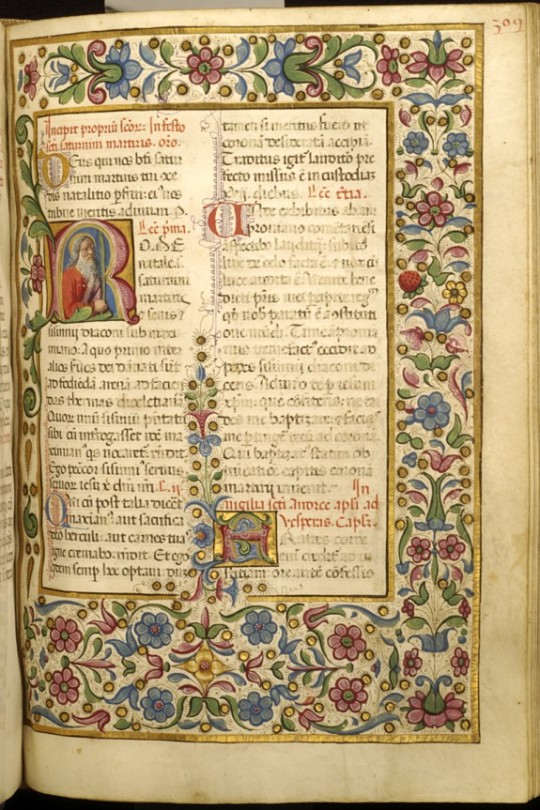
Benedetto Bordon (Italian, 1450-1530) (Artist) PERIOD ca. 1480
Source
45 notes
·
View notes
Link
Bridge 2 Business present the annual Fresh Start event for all college students and staff.
Join us for an afternoon filled with inspiring talks and practical workshops.
Wednesday, 20th September 2017, 12:00pm – 4:00pm
Speakers will give you insights on topics ranging from video marketing, branding on a budget to business planning and much more...
Speakers include:
Fynn Elkington
Claire Halligan
Sporting Chance
Anna Devitt
Benedetto Bordone
Stay tuned for further announcements
FREE entry & food - Limited spaces so grab your ticket fast.
Contact us on email if you have any questions - [email protected]
Click on the link to book tickets........
Savoy Tower
77 Renfrew Street
Glasgow
G2 3BZ
Scotland
United Kingdom
1 note
·
View note
Photo
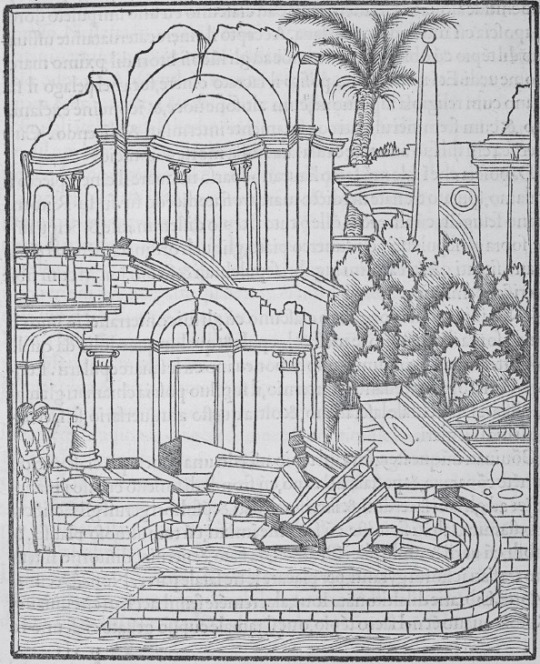
Attributed to Benedetto Bordone, The Ruined and Deserted Temple, Woodcut.
From Francesco Colonna, Hypnerotomachia Poliphili, Venice, Aldus Manutius, 1499.
#Francesco Colonna#Hypnerotomachia Poliphili#Benedetto Bordone#ruins#architecture#colonna#renaissance#drawing#woodcut
21 notes
·
View notes
Photo
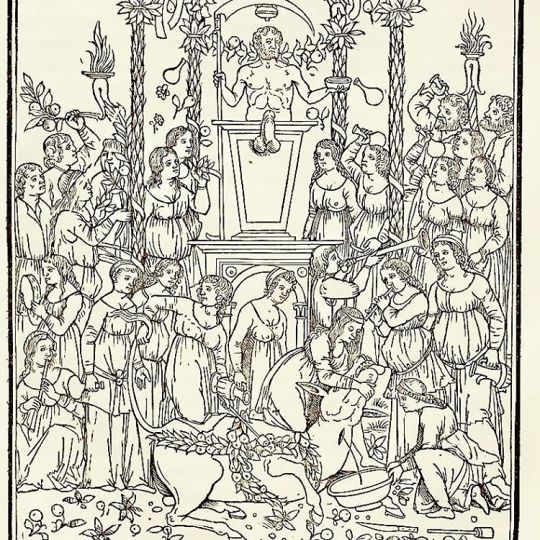
Hypnerotomachia Poliphili. Biblioteca Marciana Venice . The book was printed by Aldus Manutius in Venice in December 1499..The subject matter lies within the tradition of the genre of Romance within the conventions of courtly love, which still provided engaging thematic matter for Quattrocento aristocrats. The Hypnerotomachia also draws from a humanist tradition of arcane writings as a demonstration of classical thought..The text of the book is written in a bizarre Latinate Italian, full of words based on Latin and Greek roots without explanation. The book, however, also includes words from the Italian language, as well as illustrations including Arabic and Hebrew words; Colonna also invented new languages when the ones available to him were inaccurate. Hypnerotomachia Poliphili Author: Written by Francesco Colonna (Italian, ca. 1453–1517) Publisher: Published by Aldo Manuzio (Italian, 1449/50–1515) Designer: Design of woodcuts attributed to Benedetto Bordone (Italian, Padua ca. 1455/60–1530 Padua, active mainly Venice from 1488) Published in: Venice Date: December 1499 Medium: Woodcut Dimensions: 11 5/8 × 8 11/16 × 1 9/16 in. (29.5 × 22 × 4 cm)
0 notes
Photo

Leaf from a Commission: St. Mark Giving the Keys of Venice to Francesco de Priuli, Benedetto Bordone, c. 1523-1524, Cleveland Museum of Art: Medieval Art
The miniature shows the enthroned figure of Saint Mark, patron saint of Venice, presenting the symbolic keys of Venice to the kneeling figure of Francesco de Priuli upon his appointment as Procurator of Saint Mark's. Beneath the miniature are twelve lines of text, the opening of a ducale issued by Doge Andrea Gritti (1523–38) announcing de Priuli's appointment, which was made in the early 1520s. The text begins, Nos Andreas Griti, Dei gratia Dux venetiarum (Our Andrea Gritti, By the Grace of God Duke of the Venetians). The illumination relates closely to the work of Benedetto Bordon, a Paduan-born miniaturist who became prominent in Venice. The decorative borders appear to be edged in thin gilt-bronze bars that give the illusion of fine metalwork. Four oval cartouches are occupied by the Lion of Saint Mark (top), the de Priuli arms (bottom), Saint Anthony the Great (right), and his symbol, a swine (left). The Priuli Arms below are festooned with wreaths and supported by mermen with horns and pink tails. This exquisite leaf exemplifies the changes in script, page layout, border decoration, and binding developed by the Italian humanist culture of the 1400s.
Size: Leaf: 23.1 x 15.7 cm (9 1/8 x 6 3/16 in.)
Medium: ink, tempera and gold on vellum
https://clevelandart.org/art/2011.69
3 notes
·
View notes
Photo
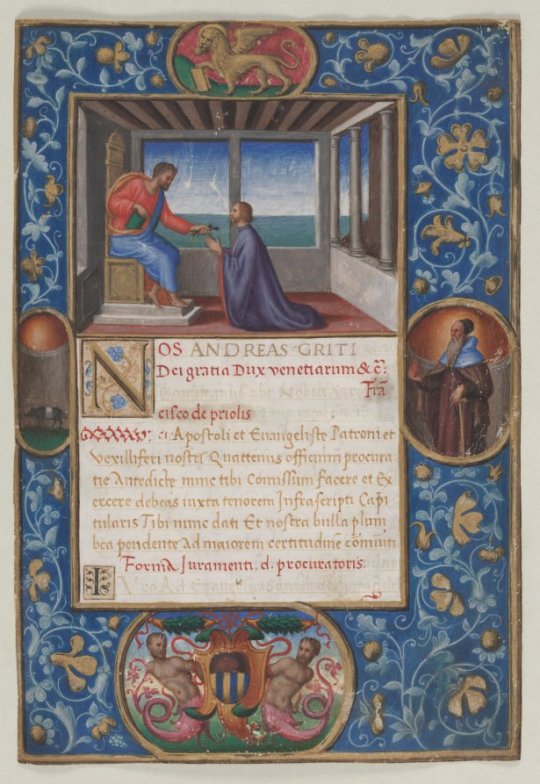
Leaf from a Commission: St. Mark Giving the Keys of Venice to Francesco de Priuli, Benedetto Bordone, c. 1523-1524, Cleveland Museum of Art: Medieval Art
The miniature shows the enthroned figure of Saint Mark, patron saint of Venice, presenting the symbolic keys of Venice to the kneeling figure of Francesco de Priuli upon his appointment as Procurator of Saint Mark's. Beneath the miniature are twelve lines of text, the opening of a ducale issued by Doge Andrea Gritti (1523–38) announcing de Priuli's appointment, which was made in the early 1520s. The text begins, Nos Andreas Griti, Dei gratia Dux venetiarum (Our Andrea Gritti, By the Grace of God Duke of the Venetians). The illumination relates closely to the work of Benedetto Bordon, a Paduan-born miniaturist who became prominent in Venice. The decorative borders appear to be edged in thin gilt-bronze bars that give the illusion of fine metalwork. Four oval cartouches are occupied by the Lion of Saint Mark (top), the de Priuli arms (bottom), Saint Anthony the Great (right), and his symbol, a swine (left). The Priuli Arms below are festooned with wreaths and supported by mermen with horns and pink tails. This exquisite leaf exemplifies the changes in script, page layout, border decoration, and binding developed by the Italian humanist culture of the 1400s.
Size: Leaf: 23.1 x 15.7 cm (9 1/8 x 6 3/16 in.)
Medium: ink, tempera and gold on vellum
https://clevelandart.org/art/2011.69
3 notes
·
View notes
Photo
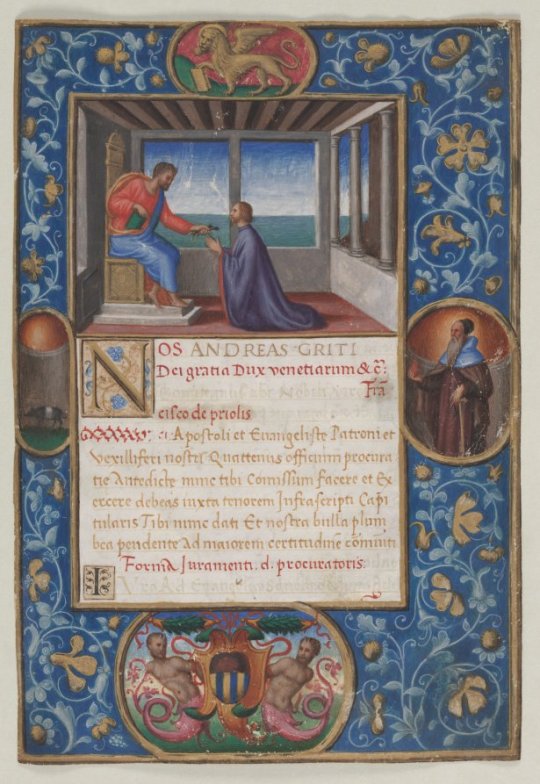
Leaf from a Commission: St. Mark Giving the Keys of Venice to Francesco de Priuli, Benedetto Bordone, c. 1523-1524, Cleveland Museum of Art: Medieval Art
The miniature shows the enthroned figure of Saint Mark, patron saint of Venice, presenting the symbolic keys of Venice to the kneeling figure of Francesco de Priuli upon his appointment as Procurator of Saint Mark's. Beneath the miniature are twelve lines of text, the opening of a ducale issued by Doge Andrea Gritti (1523–38) announcing de Priuli's appointment, which was made in the early 1520s. The text begins, Nos Andreas Griti, Dei gratia Dux venetiarum (Our Andrea Gritti, By the Grace of God Duke of the Venetians). The illumination relates closely to the work of Benedetto Bordon, a Paduan-born miniaturist who became prominent in Venice. The decorative borders appear to be edged in thin gilt-bronze bars that give the illusion of fine metalwork. Four oval cartouches are occupied by the Lion of Saint Mark (top), the de Priuli arms (bottom), Saint Anthony the Great (right), and his symbol, a swine (left). The Priuli Arms below are festooned with wreaths and supported by mermen with horns and pink tails. This exquisite leaf exemplifies the changes in script, page layout, border decoration, and binding developed by the Italian humanist culture of the 1400s.
Size: Leaf: 23.1 x 15.7 cm (9 1/8 x 6 3/16 in.)
Medium: ink, tempera and gold on vellum
https://clevelandart.org/art/2011.69
6 notes
·
View notes
Photo

Leaf from a Commission: St. Mark Giving the Keys of Venice to Francesco de Priuli, Benedetto Bordone, c. 1523-1524, Cleveland Museum of Art: Medieval Art
The miniature shows the enthroned figure of Saint Mark, patron saint of Venice, presenting the symbolic keys of Venice to the kneeling figure of Francesco de Priuli upon his appointment as Procurator of Saint Mark's. Beneath the miniature are twelve lines of text, the opening of a ducale issued by Doge Andrea Gritti (1523–38) announcing de Priuli's appointment, which was made in the early 1520s. The text begins, Nos Andreas Griti, Dei gratia Dux venetiarum (Our Andrea Gritti, By the Grace of God Duke of the Venetians). The illumination relates closely to the work of Benedetto Bordon, a Paduan-born miniaturist who became prominent in Venice. The decorative borders appear to be edged in thin gilt-bronze bars that give the illusion of fine metalwork. Four oval cartouches are occupied by the Lion of Saint Mark (top), the de Priuli arms (bottom), Saint Anthony the Great (right), and his symbol, a swine (left). The Priuli Arms below are festooned with wreaths and supported by mermen with horns and pink tails. This exquisite leaf exemplifies the changes in script, page layout, border decoration, and binding developed by the Italian humanist culture of the 1400s.
Size: Leaf: 23.1 x 15.7 cm (9 1/8 x 6 3/16 in.)
Medium: ink, tempera and gold on vellum
https://clevelandart.org/art/2011.69
7 notes
·
View notes
Photo

Benedetto Bordon (Italian, 1450-1530) (Artist) PERIOD ca. 1480 (Renaissance) MEDIUM ink, paint and gold on parchment (Manuscripts & Rare Books)
Source
55 notes
·
View notes